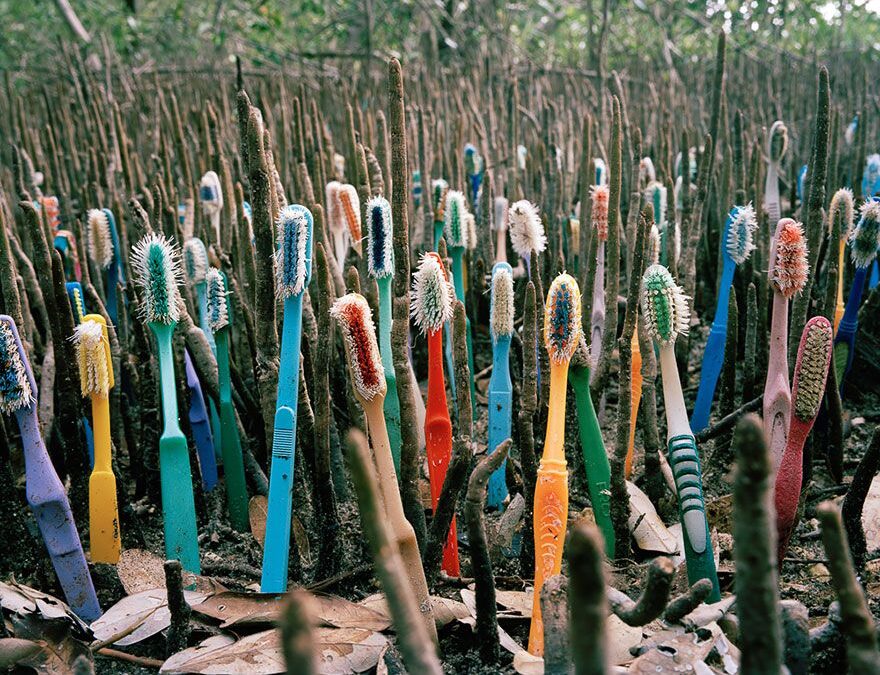The transition from natural and biodegradable materials to synthetic has a significant influence. In today’s era, plastic has dominated as the main material for a couple of decades. The main reason for this is its low cost.
It is also because of its simple production process. Not only that but also because of its adaptability and water resistance capacity. It has allowed mankind to achieve technical improvements in many sectors of life.
But the environmental consequences are severe. As plastic’s chemical composition makes it resistant to natural destruction. The majority of the materials used to make toothbrushes are polymers.
This requires energy to produce. Polypropylene, polyethylene, and nylon are the most common materials. Handles are made of polypropylene or polyethylene.
Also, the most common bristle substance is nylon. To be specific, it is Nylon 6. So, it’s impossible to brush our teeth without coming into contact with a polymer.
Plastic is indestructible. So, that signifies that every toothbrush produced since the 1930s is still there. It is still visible somewhere on the globe as a piece of garbage.
What is the manufacturing process for plastic toothbrushes?
Plastic pellets are heated in the very first step in the production process. It will then be fed into the toothbrush mold through a metal tube. Next is that the molten plastic is maintained in place in the mold in a liquid condition.
The process will only be done until it cools and solidifies into a plastic toothbrush.
So, how did your toothbrushes pollute and become part of the plastic crisis?
There are certain reasons why, and these are as follows:
Many toothbrushes are unrecyclable due to the composite polymers used in their manufacture.
It’s difficult to find brushes that aren’t made of plastic. One main reason is that toothbrush bristles are made of nylon. If you’re wondering why it’s because cleans and lasts longer than any other material.
This can make any user able to brush their teeth without needing to worry about toothbrush bristles.
Plastics in toothbrushes last longer in the trash. The existence of plastic toothbrushes stains landfills. They discharge poisons into the air as they sink into the landfill.
As a result, the ecology is harmed even more.
Plastic makes up the majority of current commercial toothbrushes. Because plastic is resistant to bacterial activity and germs. In addition, it won’t break it down while you’re using it.
Instead, it will allow you to sterilize your toothbrush more effectively.
Did you know?
Manufacturers began using nylon and other polymers in toothbrushes in the twentieth century. The rationale is straightforward. The total number of plastic toothbrushes used and tossed away each year has risen.
Most especially when the first one was produced in the 1930s.
Manual and electric toothbrushes are now available in a variety of forms and sizes. It has plastic molded handles and nylon bristles as its most common materials. These other plastic components make them simpler to grasp and operate.
The most modern toothbrush types include its handle. This can be straight, angled, curved, or contoured. It also has grips and soft rubber sections.
It’s hard to replace this plastic material with another alternative. This is the very reason why most manufacturers prefer to have this plastic component.
Every year, 3.5 billion toothbrushes are sold throughout the world. The majority of them get lost in the recycling process and wind up in landfills, rivers, and seas. This toothbrush is comprised of nylon and polypropylene plastic.
And we all know that its decomposition can take up to 500 years or more.
We can fight back against plastic pollution, which is the good news. Every small effort we make to limit our plastic usage is a significant step. It can contribute a lot to our planet’s and wildlife’s futures.
Many individuals have moved to electronic toothbrushes or zero-waste toothbrushes. This amount is a worst-case scenario estimate and is not definitive. Companies and manufacturers are gradually beginning to invest in natural-source plastic replacements.
Including its bristles, handles, or packaging. Bamboo toothbrushes, for example, have become popular in recent years. And it is available in every pharmacy and supermarket.
Bamboo is the world’s fastest-growing plant and has inherent antibacterial properties. As a result, it’s an excellent renewable material for toothbrushes.
This transition is forward-thinking and a step in the right direction. However, there is currently no regulation in place for plastic toothbrushes. Let’s face it: The problem of plastic toothbrush usage is not the main reason for pollution.
Instead, it appears to be a practical and simple way to begin.
It is washing up on beaches, endangering marine life, according to Oceana. Stomachs and digestive organs are sliced by these plastic devices. The animal may suffocate if a plastic item becomes stuck.
But, there are three things you may do to contribute to the solution:
- Begin using bamboo brushes and properly dispose of them.
- Select a brush that has a re-usable handle.
- Contact your preferred company and request that they look for plastic alternatives.
TakeAway
Each plastic toothbrush has an environmental impact. In the United States, one billion plastic toothbrushes are discarded each year. This number can accumulate a total of fifty million pounds of garbage. So, if you want to help and cut down on the situation, don’t contribute to it. Start recycling your plastic toothbrush now. Also, replace it with a non-toxic silicone toothbrush. It can at least help preserve the environment.

